1993 CADILLAC ELDORADO lights
[x] Cancel search: lightsPage 125 of 398
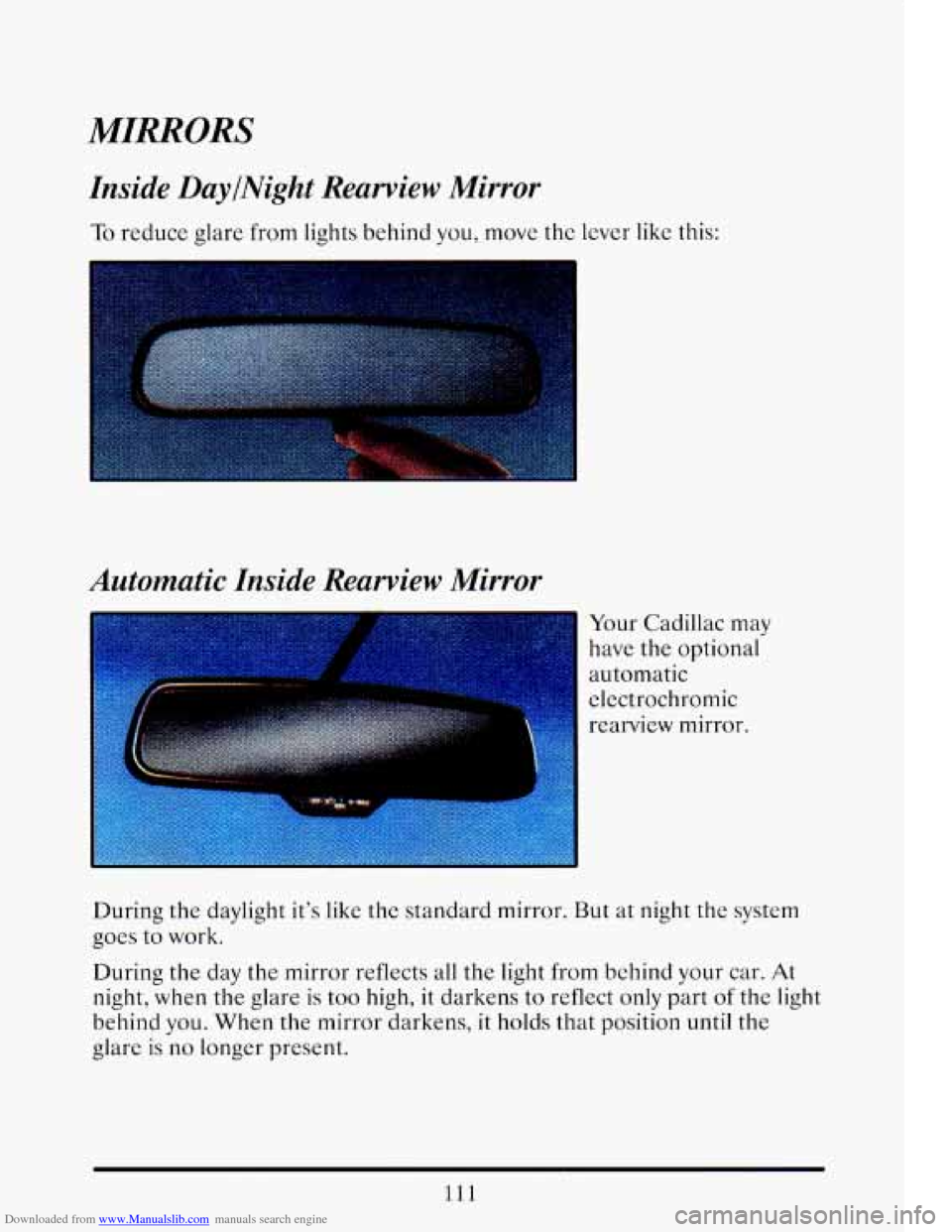
Downloaded from www.Manualslib.com manuals search engine MIRRORS
Inside DaylNight Rearview Mirror
To reduce glare from lights behind you, move the lever like this:
Automatic Inside Rearview Mirror
Your Cadillac may
have the optional
automatic
electrochromic
rearview mirror.
During the daylight it’s like
the standard mirror. But at night the system
goes to work.
During the day
the mirror reflects all the light from behind your car. At
night,
when the glare is too high, it darkens to reflect only part of the light
behind
you. When the mirror darkens, it holds that position until the
glare
is no longer present.
111
Page 126 of 398
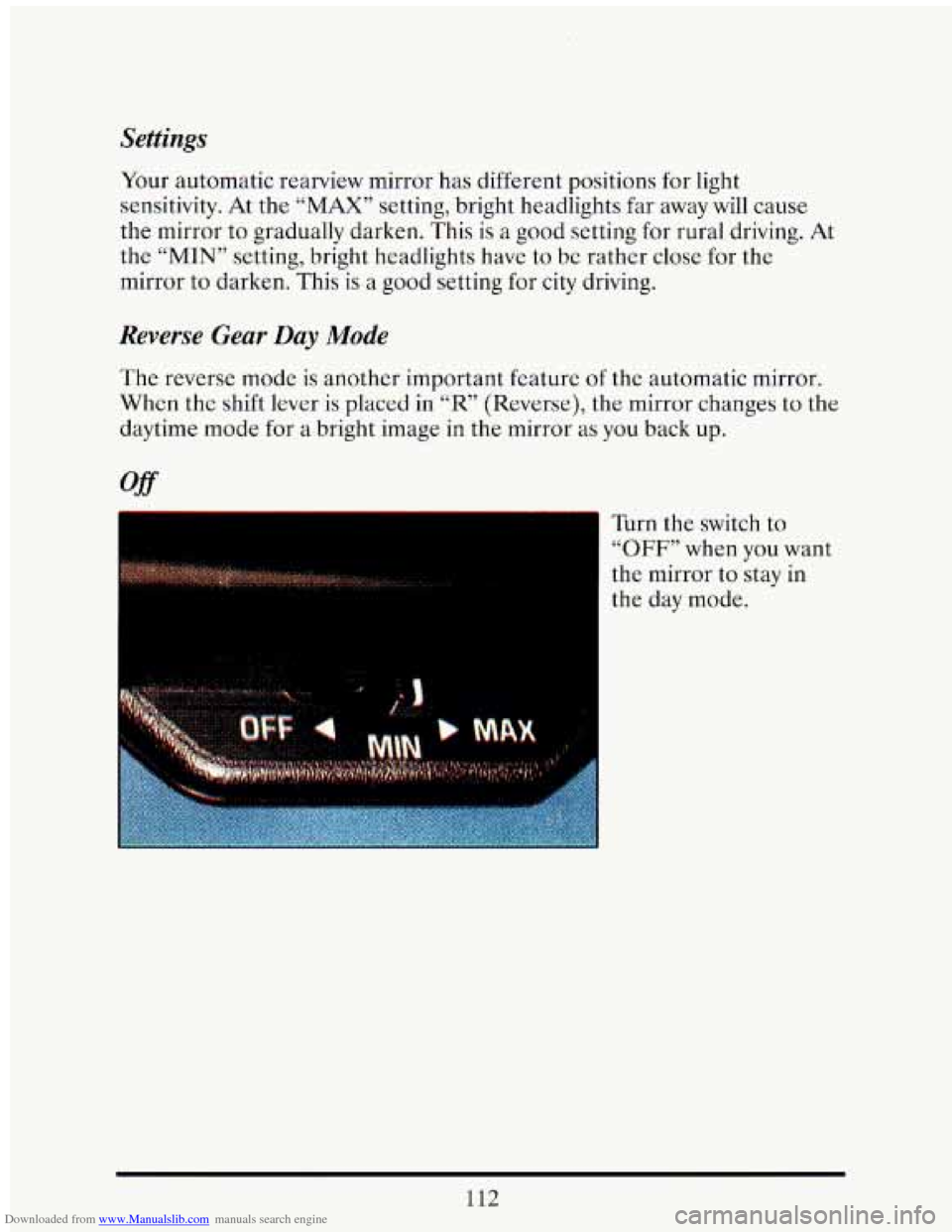
Downloaded from www.Manualslib.com manuals search engine Settings
Your automatic rearview mirror has different positions for light
sensitivity. At the
“MAX” setting, bright headlights far away will cause
the mirror
to gradually darken. This is a good setting for rural driving. At
the
“MIN” setting, bright headlights have to be rather close for the
mirror to darken.
This is a good setting €or city driving.
Reverse Gear Day Mode
The reverse mode is another important feature of the automatic mirror.
When the shift lever is placed
in “R’ (Reverse), the mirror changes to the
daytime mode
for a bright image in the mirror as you back up.
~ Turn the switch to
“OFF” when you want
the day mode.
....e >: . :.._ ..., the mirror to stay in X.<.,?.# ,. , .j ;.c.,c<- *_,i iil .. , .:: .. , .
.. .
112
Page 137 of 398
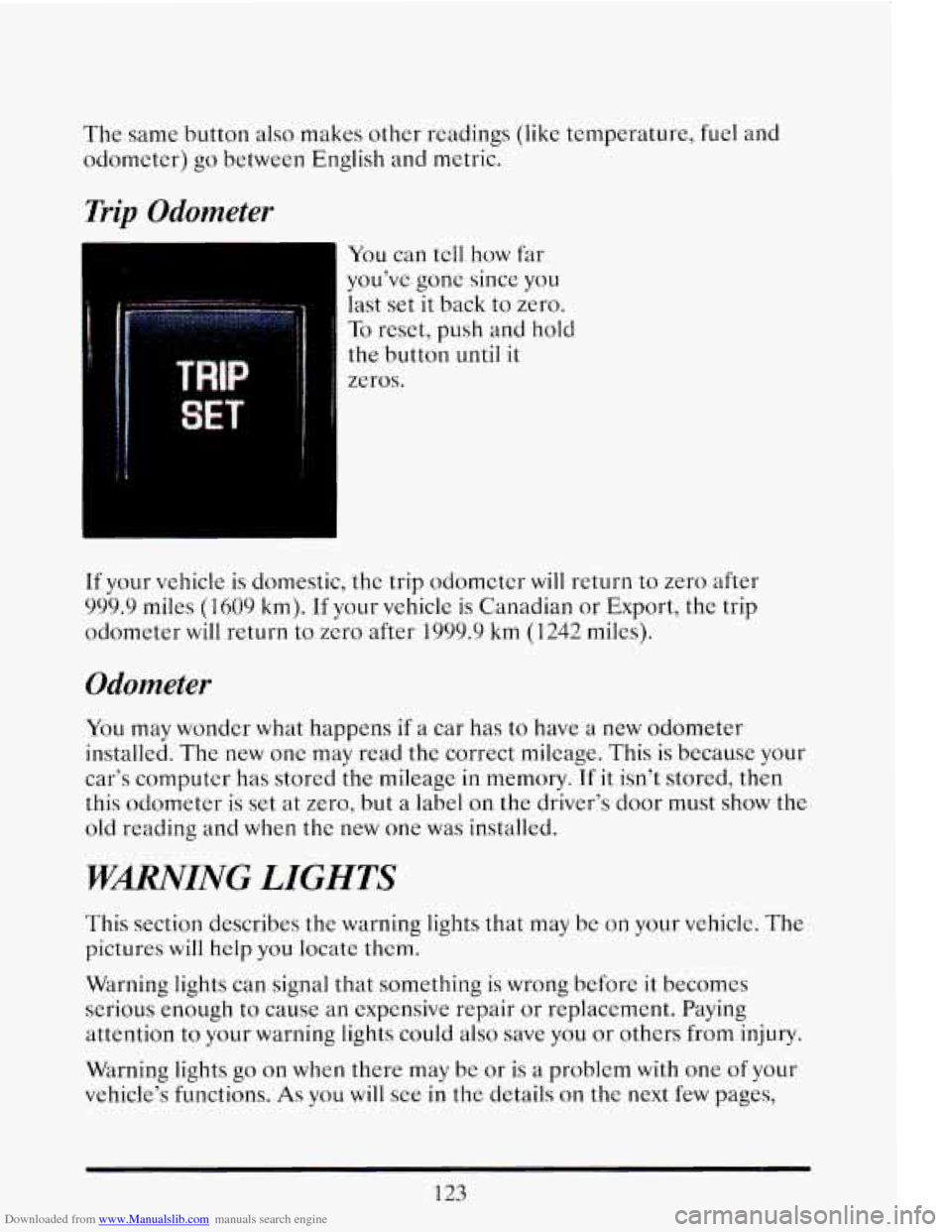
Downloaded from www.Manualslib.com manuals search engine The same button also makes other readings (like temperature, fuel and
odometer)
go between English and metric.
Trip Odometer
You can tell how far
you’ve
gonc since you
last set it back to zero.
To reset, push and hold
the button until it
zeros.
If your vehicle
is domestic, the trip odometer WIII return to zero after
999.9 miles (1609 km). If your vehicle is Canadian or Export, the trip
odometer will return
to zero after 1999.9 km (1242 miles).
Odometer
You may wonder what happens if a car has to have a new odometer
installed. The new one may read the correct mileage. This is because your
car’s computer has stored the mileage in memory.
If it isn’t stored, then
this odometer is set at zero, but
a label on the driver’s door must show the
old reading and when the new one was installed.
‘WARNING LIGHTS
This section describes the warning lights that may be on your vehicle. The
pictures will help you locate them.
Warning lights can signal that something is wrong before it becomes
serious enough
to cause an expensive repair or replacement. Paying
attention
to your warning lights could also save you or others from injury.
Warning lights
go on when there may be or is a problem with one of your
vehicle’s functions.
As you will see in the details on the next few pages,
123
Page 138 of 398
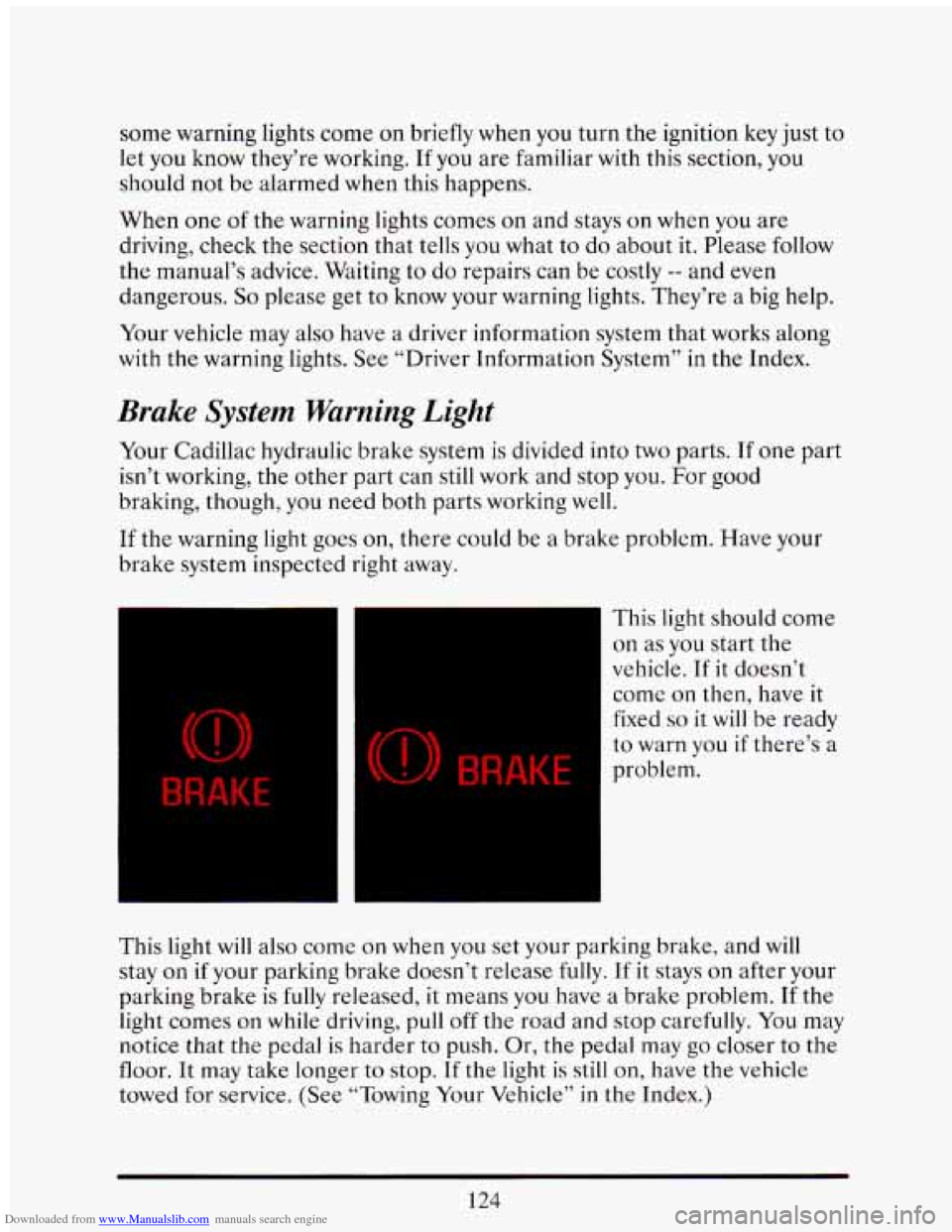
Downloaded from www.Manualslib.com manuals search engine some warning lights come on briefly when you turn the ignition key just to
let you know they’re working.
If you are familiar with this section, you
should not be alarmed when this happens.
When one
of the warning lights comes on and stays on when you are
driving, check the section that tells you what to do about it. Please follow
the manual’s advice. Waiting to do repairs can be costly
-- and even
dangerous.
So please get to know your warning lights. They’re a big help.
Your vehicle may
also have a driver information system that works along
with the warning lights. See “Driver Information System” in the Index.
Brake System Warning Light
Your Cadillac hydraulic brake system is divided into two parts. If one part
isn’t working, the other part can still work and stop you. For good
braking, though, you need both parts working
well.
If the warning light goes on, there could be a brake problem. Have your
brake system inspected right away.
BRAKE
(0) BRAKE
This light should come
on as you start the
vehicle. If it doesn’t
come
on then, have it
fixed
so it will be ready
to warn you if there’s a
problem.
This light will also come
on when you set your parking brake, and will
stay
on if your parking brake doesn’t release fully. If it stays on after your
parking brake
is fully released, it means you have a brake problem. If the
light comes
on while driving, pull off the road and stop carefully. You may
notice that the pedal is harder
to push. Or, the pedal may go closer to the
floor. It may take longer to stop.
If the light is still on, have the vehicle
towed for service. (See “Towing Your Vehicle” in
the Index.)
124
Page 148 of 398
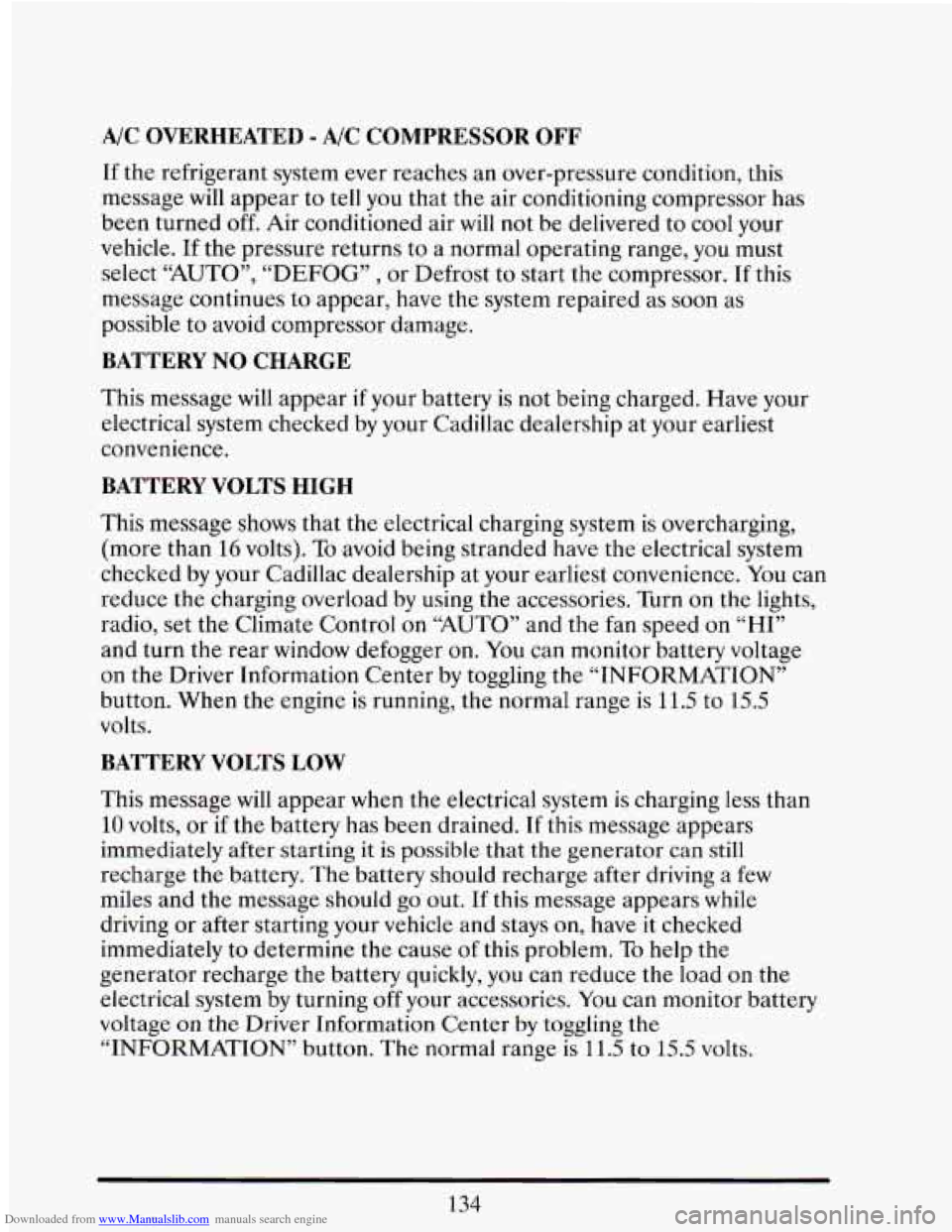
Downloaded from www.Manualslib.com manuals search engine A/C OVERHEATED - A/C COMPRESSOR OFF
If the refrigerant system ever reaches an over-pressure condition, this
message
will appear to tell you that the air conditioning compressor has
been turned
off. Air conditioned air will not be delivered to cool your
vehicle. If the pressure returns
to a normal operating range, you must
select “AUTO”, “DEFOG”
, or Defrost to start the compressor. If this
message continues to appear, have the system repaired as soon as
possible to avoid compressor damage.
BATTERY NO CHARGE
This message will appear if your battery is not being charged. Have your
electrical system checked by
your Cadillac dealership at your earliest
convenience.
BATTERY VOLTS HIGH
This message shows that the electrical charging system is overcharging,
(more than
16 volts). To avoid being stranded have the electrical system
checked by your Cadillac dealership at your earliest convenience.
You can
reduce the charging overload
by using the accessories. Turn on the lights,
radio, set the Climate Control on
“AUTO” and the fan speed on “HI”
and turn the rear window defogger on. You can monitor battery voltage
on the Driver Information Center by toggling the “INFORMATION’’
button. When the engine is running, the normal range is
11.5 to 15.5
volts.
BATTERY VOLTS LOW
This message will appear when the electrical system is charging less than
10 volts, or if the battery has been drained. If this message appears
immediately after starting it is possible
that the generator can still
recharge the battery. The battery should recharge after driving a few
miles and the message should go out. If this message appears while
driving or after starting
your vehicle and stays on, have it checked
immediately to determine the cause
of this problem. To help the
generator recharge the battery quickly, you can reduce the load on the
electrical system by turning
off your accessories. You can monitor battery
voltage
on the Driver Information Center by toggling the
“INFORMATION” button. The normal range is 11.5 to 15.5 volts.
134
Page 184 of 398

Downloaded from www.Manualslib.com manuals search engine TRAFFIC LIGHTS
I
7
I
We're all familiar with traffic lights or stop lights. Often green arrows are
being used in the lights for improved traffic control. On some multilane
roads, green arrows light up, indicating that traffic in one or more lanes
can move or make a turn. Green arrows don't mean "go no matter what."
You'll still need to proceed with caution, yielding the right of way to
pedestrians and sometimes to other vehicles.
Some traffic lights also use red arrows to signify that you must
stop before
turning on red.
1
REVERSIBLE LANE
ON
LANE
ROADWAY
MULTI-
€3
€3
0
f3
n
Page 186 of 398

Downloaded from www.Manualslib.com manuals search engine TRAFFIC OFFICER
The traffic police officer is also a source of important information. The
officer’s signals govern, no matter what the traffic lights
or other signs
say.
The next section discusses some
of the road conditions you may
encounter.
DEFENSIVE DMNG
The best advice anyone can give about driving is: Drive defensively.
Please start with a
very important safety device in your Cadillac: Buckle
up. (See “Safety Belts” in the Index.)
Defensive driving really means “be ready for anything.” On city streets,
rural roads, or freeways, it means “always expect the unexpected.”
Assume that pedestrians or other drivers are going to be careless and
make mistakes. Anticipate what they might do. Be ready for their
mistakes.
Expect children to dash out from behind parked cars, often followed by
other children. Expect occupants in parked cars to open doors into traffic.
Watch for movement in parked cars
-- someone may be about to open a
door.
Expect other drivers to run stop signs when you are
on a through street.
Be ready to brake if necessary as
you go through intersections. You may
not have to use the brake, but if
you do, you will be ready.
If you’re driving through a shopping center parking lot where there are
well-marked lanes, directional arrows, and designated parking are\
as,
expect some drivers to ignore all these markings and dash straight toward
one part
of the lot.
Pedestrians can be careless. Watch for them. In general, you must give
way
to pedestrians even if you know you have the right of way.
Rear-end collisions are about the most preventable of accidents. Yet they
are common. Allow enough following distance. It’s the best defensive
driving maneuver,
in both city and rural driving. You never know wh.en
the vehicle in front
of you is going to brake or turn suddenly.
172
Page 197 of 398

Downloaded from www.Manualslib.com manuals search engine Steering Tips
Driving on Curves
It’s important to take curves at a reasonable speed.
A lot of the “driver lost control” accidents mentioned on the news
happen on curves. Here’s why:
Experienced driver or beginner, each of
us is subject to the same laws of
physics when driving on curves. The traction
of the tires against the road
surface makes it possible for the vehicle to change its path
when you turn
the front wheels. If there’s
no traction, inertia will keep the vehicle going
in the same direction.
If you’ve ever tried to steer a vehicle on wet ice,
you’ll understand this.
The traction you can get in a curve depends on the condition
of your tires
and the road surface,
the angle at which the curve is banked, and your
speed. While you’re in a curve, speed is the one factor you can control.
Suppose you’re steering through
a sharp curve. Then you suddenly
accelerate.
Those two control systems -- steering and acceleration -- can overwhelm
those places where the tires meet the road and make you lose control.
What should you do if this ever happens? Let up on the accelerator
pedal, steer the vehicle the way
you want it to go, and slow down.
Speed limit signs near curves warn that you should adjust your speed.
Of
course, the posted speeds are based on good weather and road
conditions. Under less favorable conditions you’ll want to go slower.
If you need to reduce your speed as you approach
a curve, do it before
you enter the curve, while your front wheels are straight ahead.
Try to adjust your speed so you can “drive” through the curve. Maintain a
reasonable, steady speed. Wait to accelerate until you are out
of the
curve, and then accelerate gently into the straightaway.
When you drive into a curve at night, it’s harder to see the road ahead of
you because it bends away from the straight beams of your lights. This is
one good reason
to drive slower.
183